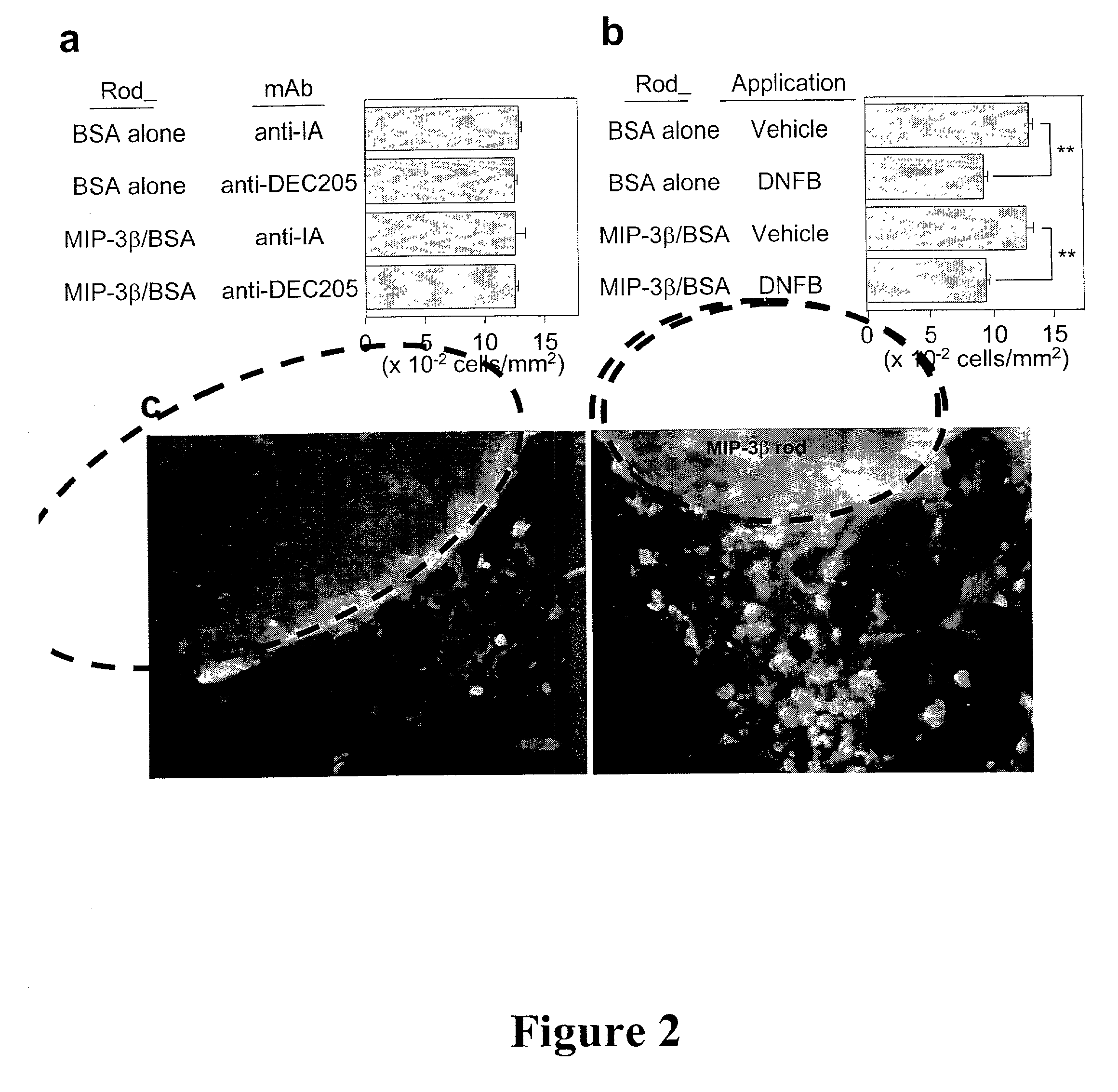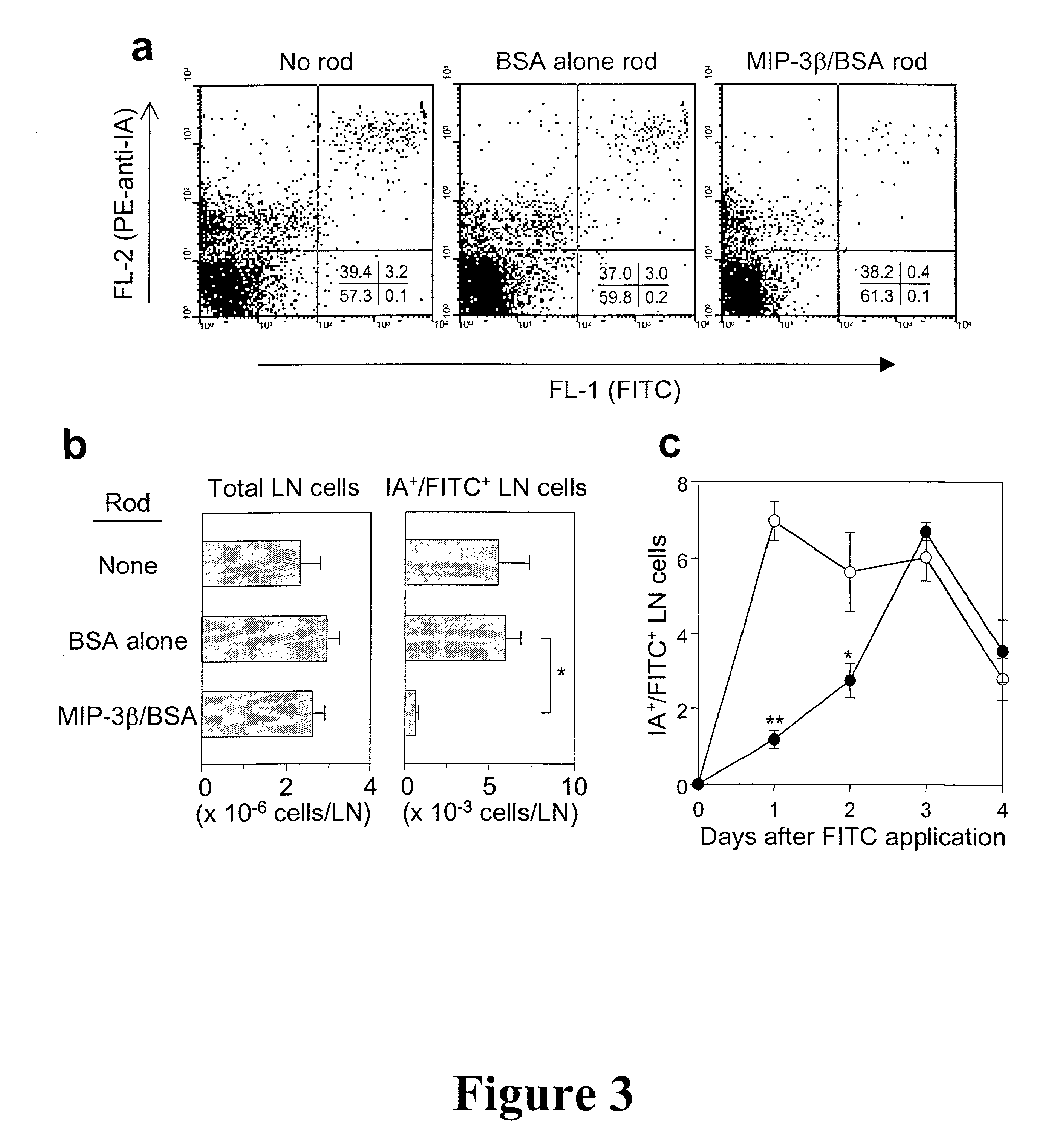In situ langerhans cell vaccine
a technology of in situ langerhans cells and vaccines, which is applied in the field of in situ langerhans cell vaccines, can solve the problems of low number of dendritic cells, unable to obtain dendritic cells in sufficient quantities, and unable to meet the requirements of francotte or urbain
- Summary
- Abstract
- Description
- Claims
- Application Information
AI Technical Summary
Problems solved by technology
Method used
Image
Examples
examples
[0074] Example 1: Preparation of EVA polymer rods
[0075] All polymer rods were prepared in the Brown University laboratory of Dr. Robert F. Valentini. MIP-3.beta. (900 ng / rod) was incorporated into the EVA polymer rods as described by Kim & Valentini, 1997, Biomaterials 18:1175-1184. Briefly, lyophilized MIP-3.beta. was reconstituted in PBS, mixed with 1% BSA (1.8 mg / rod added as a carrier protein), snap frozen in liquid nitrogen, and re-lyophilized. EVA copolymer pellets (DuPont, Wilmington, Del.) were washed extensively and dissolved in methylene chloride to obtain a 1% solution (w / v). The lyophilized MIP-3.beta.-BSA mixture was then added to the polymer solution with the ratio of 40:60 by weight, vortexed, snap frozen, and re-lyophilized. The resulting powder was melt-extruded at 50.degree. C. into continuous polymer rods with a diameter of 0.7 mm. Rods were cut into 10 mm pieces and coated by dipping in a 5% EVA-methylene chloride solution. EVA rods containing BSA or OVA (1.8 mg / ...
example 4
[0085] LC entrapment
[0086] After 24 hr pre-incubation in PBS at 37.degree. C., a MIP-3.beta. or BSA rod was cut into 4 short pieces (2.5 mm length) and implanted subcutaneously into a mouse with 200 .mu.l of PBS using a 20G1 / 2 needle. At 24 hr post-implantation, 20 .mu.l of 0.5% dinitroflourobenzene (DNFB) or 3% fluorescein isothiocyanate (FITC) was carefully applied over the implantation sites (10 mm-diameter circles marked with black ink immediately after implantation).
[0087] Subcutaneous implantation of EVA polymer rods containing MIP-3.beta. (900 ng / rod / animal) did not affect the number of LC that remained in the overlaying epidermis (FIG. 2a) or cause significant accumulation of IA.sup.+ cells (IA.sup.+ serves as a marker for APCs) around the implanted rods at 24 hour pont-implantation. In an attempt to induce LC maturation and elevate MIP-3.beta. responsiveness, DNFB was applied over the implantation sites. Significant (25-30%) reduction was observed in surface LC densities 2...
example 6
[0092] Loading of LC in situ
[0093] For in situ LC loading with antigen, a pre-soaked OVA rod (OVA was used as a model tumor associated antigen) containing 1.8 mg / rod / animal was cut into 4 pieces and co-implanted with a MIP-3.beta. or BSA rod into an animal (C57BL / 6 mice) and the implantation site was painted with DNFB 24 hr later. FIGS. 4a and 4b show induction of tumor-specific CTL activities an protective immunity by in situ LC loaded cells in three groups. The first group of C57BL / 6 mice received co-implantation of MIP-3.beta. rods+OVA rods on the abdomen followed by application of DNFB at the implantation site (circles), the second group received coimplantation of BSA rods+OVA rods on the abdomen followed by application of DNFB at the implantation site (squares) and the third group received implantation of MIP-3.beta. rods on the back and OVA rods on the abdomen, followed by DNFB application at the site of implantation of the MIP-3.beta. rods on the back. Spleen cells were harv...
PUM
| Property | Measurement | Unit |
|---|---|---|
| concentrations | aaaaa | aaaaa |
| length | aaaaa | aaaaa |
| diameter | aaaaa | aaaaa |
Abstract
Description
Claims
Application Information
 Login to View More
Login to View More - R&D
- Intellectual Property
- Life Sciences
- Materials
- Tech Scout
- Unparalleled Data Quality
- Higher Quality Content
- 60% Fewer Hallucinations
Browse by: Latest US Patents, China's latest patents, Technical Efficacy Thesaurus, Application Domain, Technology Topic, Popular Technical Reports.
© 2025 PatSnap. All rights reserved.Legal|Privacy policy|Modern Slavery Act Transparency Statement|Sitemap|About US| Contact US: help@patsnap.com



